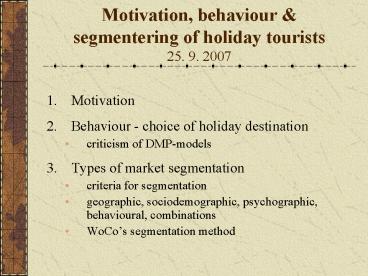Motivation, behaviour - PowerPoint PPT Presentation
1 / 16
Title:
Motivation, behaviour
Description:
sexual orientation 'the pink dollar' age & family life cycle ... All inclusive holiday to a popular destination, sun sea sand, experiences in groups ... – PowerPoint PPT presentation
Number of Views:31
Avg rating:3.0/5.0
Title: Motivation, behaviour
1
Motivation, behaviour segmentering of holiday
tourists25. 9. 2007
- Motivation
- Behaviour - choice of holiday destination
- criticism of DMP-models
- Types of market segmentation
- criteria for segmentation
- geographic, sociodemographic, psychographic,
behavioural, combinations - WoCos segmentation method
2
Motivational Dynamics(Arnould et al. p.266)
Comparison
Differentiation
Affiliation
3
Self- actualization Ego Social Safety
Security Physiological
Maslows need hierarchy Arnould et al. p.270
4
Pearces travel-needs model in Goeldner
Ritchie 2006 p.257
Fulfilment needs
Self-esteem/development needs
Other directed
Self-directed
Relationship needs
Other directed
Self-directed
Safety/security needs
Self-directed
Other directed
Physiological
Externally oriented
Internally oriented
5
Source Gartner (1993) pp.194-195.
6
Criticism of sequential DMP-models(Decrop
Snelders 2002)
- see consumers as rational problem solvers
- see decisions as sequential, hierarchical
step-by-step - need for a more experience based understanding of
tourists decision making - feelings, phantasy, nostalgia, day dreaming
influence DMP - interpersonal dimension is missing influence
from other DMUs
7
Criteria for effective segmentation (Weaver
Lawton )
- Measurability
- Size
- Homogeneity
- Accessibility
- Compatibility
- Actionability
- Durability
- Relevance
8
Four important segmentation types(Moscardo et
al. 2001)
9
Geographical segmentation
- continents, countries, regions, rural vs. urban
place - geographical unit consumption culture
- today used in combination with other factors
- Eg VDK develop new geographical markets Japan,
China, South Korea --- Scandinavian Tourist Board
10
Socio-demographic segmentation
- gender /- traditional gender perspective
- sexual orientation the pink dollar
- age family life cycle
- education, profession, income
- religion, race, ethnicity
11
Psychographic segmentation
- Lifestyle
- combinations of motivation, personality type,
attitudes and perceptions - Personality types Plog (p.186)
- allocentric midcentric psychocentric
- popular but unclear methodological/empirical
background
12
Behavioural segmentation
- Number of destinations visited
- single vs. multiple destination holidays
- Single vs. repeat visitors
- Type of transportation, accommodation, activity
- eg. bus tourists, camping tourists, seasand
tourists
13
Institutionalised vs. non-institutionalised
tourist (Cohen, 1972)
- Organised mass tourist
- All inclusive holiday to a popular destination,
sunseasand, experiences in groups - Individual mass tourist
- More flexible package, popular destination, more
on your own - Explorer
- Self-organised, avoids other tourists, meeting
the locals, dependent on tourism system for
comfort security - Drifter
- Self-organised, to be part of a local culture,
minimal planning, no contact with tourism industry
14
New Tourists (Poon 1993, in short)
15
WoCos segmentation method
- Discuss WoCos segmentation strategy what types
do they use pros/cons of these? - Discuss alternative segmentation strategies for
WoCo
16
Further readings
- Arnould E., Price L., Zinkhan G. (2004)
Consumers. 2nd ed. New York MCGraw Hill. - Cohen E. (1972) Towards a Sociology of
International Tourism. Social Research 39,
pp.164-182 - Moscardo G, Pearce P., Morrison A. (2001).
Evaluation Different Bases for Market
Segmentation A Comparison of Geographic Origin
versus Activity Participation for Generating
Tourist Market Segments. Journal of Travel and
Tourism Marketing, 10, 1, pp.29-49 - Plog S (2002) The Power of Psychographics and
the Concept of Venturesomeness. Journal of Travel
Research, 40, pp.244-251. - Poon A. (1993) Tourism, Technology and
Competitive Strategies. Wallingford CAB
International































